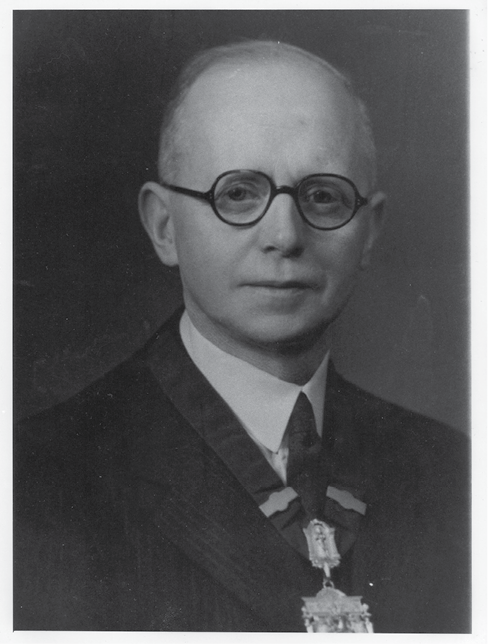John Gillies had a profound influence on establishing anaesthesia in the UK as a specialty on equal standing with surgery and medicine. He was renowned for his clinical teaching and mentoring. Seven anaesthetists who trained under his tutelage at the Royal Infirmary of Edinburgh (RIE) in the early post-Second World War years, went on to become professors of anaesthesia. Internationally, he was very much involved in the establishment of the World Federation of Societies of Anaesthesiologists, which held its first congress at Scheveningen, The Netherlands in 1955.
Born in Edinburgh, John Gillies was admitted to the University Medical School there in 1913 but interrupted his studies to serve in the Highland Light Infantry from 1914 to 1918. He spent the last 7 months as a prisoner of war and was awarded the Military Cross. After resuming medical studies in Edinburgh, he qualified in 1923, and went to be house physician at Cumberland Infirmary, Carlisle. Then in 1924 he entered general practice in the West Riding of Yorkshire, where a significant part of his work was the administration of anaesthetics. He realised that he needed wider experience and training to specialise in anaesthesia, so in 1931 he went to London to be supervised by the doyen, Ivan Magill, and others. He moved back to Edinburgh in 1932, and in 1940 became the founding head of the Department of Anaesthetics at the RIE. There he designed a new anaesthetic machine; a prototype was built on site about 1941, after which it was produced commercially. In 1944 Gillies co-authored (with RJ Minnitt) the sixth edition of Textbook of Anaesthetics, formerly Ross and Fairlie’s Handbook of Anaesthetics. After the Second World War, in 1946, Gillies was invited to be Director of Anaesthesia to the RIE and Lecturer to the University of Edinburgh (later Simpson Reader). Although quiet and gentle by nature he demanded a high academic standard.
John Gillies also served on the Editorial Board of the British Journal of Anaesthesia until 1948. That year was the start of the National Health Service, which had two highly significant terms of reference for the specialty of anaesthesia. First, consultant anaesthetists were to be given equal status to other specialists, and second, such appointment was to be dependent on the achievement of high academic standard. From 1947–50 Gillies (Figure 1) was President of the Association of Anaesthetists of Great Britain and Ireland, completing ongoing negotiations with the Royal College of Surgeons of England to form a Faculty of Anaesthetists; the Diploma in Anaesthetics was upgraded to a two-part examination. Not surprisingly, Gillies was a founder member of the Board of the Faculty of Anaesthetists, formed in March 1948.
Figure 1 John Gillies wearing the presidential badge of the Association of Anaesthetists. Image courtesy of the Association of Anaesthetists of Great Britain and Ireland

Concurrently, at the RIE the distinguished surgeon, Professor James Learmonth was performing the operation of thoraco-lumbar splanchnicectomy and sympathectomy as a treatment for severe essential hypertension. An unwanted accompaniment was severe haemorrhage, inciting Learmonth to demand a ‘bloodless field’, which meant a new anaesthetic technique. This was accomplished by HWC Griffiths and John Gillies whose high spinal anaesthesia induced hypotension; they published it in the December 1948 issue of the journal Anaesthesia. Gillies further publicised the technique when he delivered the Joseph Clover Lecture of the Faculty of Anaesthetists in 1950, coining the term ‘physiological trespass’.
The reputation of the RIE was such that in March 1949, it provided surgeon (James Learmonth) anaesthetist (John Gillies) and Theatre Sister, who travelled to Buckingham Palace to perform a lumbar sympathectomy on King George VI (to relieve leg pain). For his part in this service, Gillies was awarded the CVO.
In 1950 John Gillies resurrected the Scottish Society of Anaesthetists, which had been dormant since 1939; he served as its President until 1951. He was also President of the Section of Anaesthetics, Royal Society of Medicine (1951–52) and of the Association of Anaesthetists of Edinburgh (1952–53). In November 1955 he was elected a Fellow of the Royal College of Physicians of Edinburgh. His department at the RIE gave outreach care for crush injuries of the chest by way of assisted ventilation. This culminated in the opening of an Assisted Ventilation Unit (Ward 19) in 1960, the year he retired. Since 1978 the Scottish Society of Anaesthetists has held an annual ‘Gillies Lecture’.
Further reading
- Gillies J. Retrospect. Scottish Society of Anaesthetists News Letter 1972; 13: 19–24.
- Masson AHB. Anaesthesia in Edinburgh 1900–1950. In: Barr AM, Boulton TB, Wilkinson DJ, Editors. Essays on the History of Anaesthesia. London: RSM Press; 1996. pp. 65–70.
- McKenzie AG. The Gillies anaesthetic machine. Anaesthesia 2008; 63: 771–7.
- Obituary J Gillies CVO, MC, MB,ChB, FRCPEd, FRCSEd, FFARCS, DA. Br Med J 1976; ii: 308.
- Gillies, John. Foundation Fellows, Faculty of Anaesthetists, Royal College of Surgeons of England. Elected in 1948. https://www.rcoa.ac.uk/sites/default/files/1948-FFARCS.pdf (accessed 01/08/19).